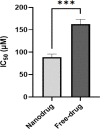Toxicity of Carboplatin-Niosomal Nanoparticles in a Brain Cancer Cell Line
- PMID: 38019259
- PMCID: PMC10772781
- DOI: 10.31557/APJCP.2023.24.11.3985
Toxicity of Carboplatin-Niosomal Nanoparticles in a Brain Cancer Cell Line
Abstract
Objective: Cancer poses a significant challenge in modern medicine, standing as the primary cause of death in many countries, second only to cardiovascular diseases. Among the various treatments available, carboplatin, a chemotherapy drug, is employed for specific cancer types, including brain carcinoma. The main objective of this investigation is to enhance the therapeutic efficacy of carboplatin by utilizing niosomal nanocarriers.
Methods: We synthesized nanoniosomal carboplatin using the reverse-phase evaporation technique and conducted an assessment of its particle size, zeta potential, and drug-release properties. Subsequently, we evaluated the cytotoxicity of nanoniosomal carboplatin using the C6 rat glioma cell line.
Results: Our research revealed that these niosomal nanoparticles possessed a particle size of 290.5±5.5 nm and a zeta potential of -21.7±7.4 mV. The amount of encapsulated drug and drug loading level were found to be 60.2±2.3% and 2.5±1.1%, respectively. Importantly, the cytotoxic impact of these nanoniosomes on the C6 rat glioma cell line exhibited a significant increase compared to the free drug (P<0.05).
Conclusion: Based on our discoveries, it is evident that carboplatin niosomal nanocarriers hold potential as an innovative approach to chemotherapy for brain cancer therapy.
Keywords: Brain cancer; Carboplatin; Nanoniosome; Nanoparticle.
Conflict of interest statement
The authors declare no potential conflict of interest.
Figures




Similar articles
-
Development and evaluation of carboplatin-loaded PCL nanoparticles for intranasal delivery.Drug Deliv. 2016 Sep;23(7):2144-2153. doi: 10.3109/10717544.2014.948643. Epub 2014 Dec 29. Drug Deliv. 2016. PMID: 25544603
-
Preparation, Characterization and Cytotoxicity of Silibinin- Containing Nanoniosomes in T47D Human Breast Carcinoma Cells.Asian Pac J Cancer Prev. 2016;17(8):3835-8. Asian Pac J Cancer Prev. 2016. PMID: 27644625
-
Evaluation the Anti-Cancer Effect of PEGylated Nano-Niosomal Gingerol, on Breast Cancer Cell lines (T47D), In-Vitro.Asian Pac J Cancer Prev. 2018 Mar 27;19(3):645-648. doi: 10.22034/APJCP.2018.19.3.645. Asian Pac J Cancer Prev. 2018. PMID: 29580033 Free PMC article.
-
Assessment of a New Ginsenoside Rh2 Nanoniosomal Formulation for Enhanced Antitumor Efficacy on Prostate Cancer: An in vitro Study.Drug Des Devel Ther. 2020 Aug 13;14:3315-3324. doi: 10.2147/DDDT.S261027. eCollection 2020. Drug Des Devel Ther. 2020. PMID: 32884236 Free PMC article.
-
Preparation and characterization of angiopep-2 functionalized Ginsenoside-Rg3 loaded nanoparticles and the effect on C6 Glioma cells.Pharm Dev Technol. 2020 Mar;25(3):385-395. doi: 10.1080/10837450.2018.1551901. Epub 2019 Dec 25. Pharm Dev Technol. 2020. PMID: 30601070
Cited by
-
Metal-based nanoparticle in cancer treatment: lessons learned and challenges.Front Bioeng Biotechnol. 2024 Jul 11;12:1436297. doi: 10.3389/fbioe.2024.1436297. eCollection 2024. Front Bioeng Biotechnol. 2024. PMID: 39055339 Free PMC article. Review.
-
Design and Development of Gold/reduced Graphene Oxide Nanocomposite loaded with Cyclophosphamide: Potential Application in Treatment of Breast Cancer.Asian Pac J Cancer Prev. 2024 Mar 1;25(3):1007-1016. doi: 10.31557/APJCP.2024.25.3.1007. Asian Pac J Cancer Prev. 2024. PMID: 38546083 Free PMC article.
-
Enhancing Cisplatin Delivery via Liposomal Nanoparticles for Oral Cancer Treatment.Indian J Clin Biochem. 2025 Apr;40(2):211-217. doi: 10.1007/s12291-024-01239-3. Epub 2024 May 28. Indian J Clin Biochem. 2025. PMID: 40123632
-
Application of Scaffold-Based Drug Delivery in Oral Cancer Treatment: A Novel Approach.Pharmaceutics. 2024 Jun 14;16(6):802. doi: 10.3390/pharmaceutics16060802. Pharmaceutics. 2024. PMID: 38931923 Free PMC article. Review.
References
-
- Alavi SE, Raza A, Esfahani MKM, et al. Carboplatin niosomal nanoplatform for potentiated chemotherapy. J Pharm Sci. 2022;111:3029–37. - PubMed
-
- Alimirzaei F, Kieslich CA. Computer Aided Chemical Engineering . Vol. 52. Elsevier; 2023. Machine learning models for predicting membranolytic anticancer peptides; pp. 2691–6.
MeSH terms
Substances
LinkOut - more resources
Full Text Sources
Medical

